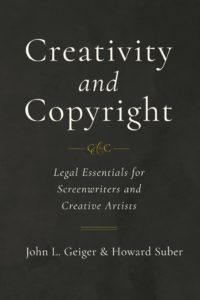BOOK REPORT – GEIGER & SUBER’S ‘CREATIVITY AND COPYRIGHT’

 In the post that inaugurated this blog back in 2012, I noted that the Copyright Act’s simple formulation–“copyright protection subsists . . . in original works of authorship fixed in any tangible medium of expression”–is never more problematic than when applied to the highly collaborative, highly derivative, and oftentimes hugely expensive and risky art and craft of film. Who is the author? What counts as originality entitled to protection? What is being expressed? When does a filmmaker use ideas available to all and when does she infringe the protected expression of another? In Creativity and Copyright: Legal Essentials for Screenwriters and Creative Artists (University of California Press), entertainment lawyer John L. Geiger and film professor Howard Suber provide a guide for the perplexed, with practical, actionable advice for novice screenwriters not only on the issues they may encounter under copyright law, but also on matters that will governed by standard contractual arrangements, rights of publicity, and the customs and practices of the industry.
In the post that inaugurated this blog back in 2012, I noted that the Copyright Act’s simple formulation–“copyright protection subsists . . . in original works of authorship fixed in any tangible medium of expression”–is never more problematic than when applied to the highly collaborative, highly derivative, and oftentimes hugely expensive and risky art and craft of film. Who is the author? What counts as originality entitled to protection? What is being expressed? When does a filmmaker use ideas available to all and when does she infringe the protected expression of another? In Creativity and Copyright: Legal Essentials for Screenwriters and Creative Artists (University of California Press), entertainment lawyer John L. Geiger and film professor Howard Suber provide a guide for the perplexed, with practical, actionable advice for novice screenwriters not only on the issues they may encounter under copyright law, but also on matters that will governed by standard contractual arrangements, rights of publicity, and the customs and practices of the industry.
Geiger and Suber begin with two complementary chapters, the first explaining what source materials the screenwriter is free to use, and the second what types of materials require legal clearance. It is, based on my experience with novice writers, the right place to start. Too often writers suffer a kind of legal writer’s block at the very outset of a project because their heads are filled with misleading anecdotes and urban legends about legal nightmares past. The authors give clear and concise explanations of such nettlesome concepts as the fact-idea dichotomy, scènes à faire, and the difference between ideas and expression.
A little too cursory, however, is the discussion of fair use, a topic I find that people who actually know nothing about copyright law often will think they know everything about. I fear the statement that with a fair use “it is as though the material were in the public domain and free for the taking” could add to the confusion this fraught subject engenders. The authors go on to state that fair use is not something to be determined by the writer herself, but by “the companies that distribute the material, using attorneys who are specialists in this area of the law.” While they are correct to caution that this is an area that requires legal advice, I think the screenwriter working on spec–to whom most of the book is addressed–could use more guidance before getting that deeply into a project.
The next two chapters deal with intensely practical problems for which copyright law provides no more than baseline, default rules that can be and usually are overridden by contract and customary practice–collaboration between writers and pitching projects to producers. Here the expertise and experience of the two authors shines through most clearly on matters in which the writer is truly on his own–studio lawyers down the road will be of no help, and likely will be on the other side of any disputes. Much of what is contained in these chapters will be beneficial not only to screenwriters, but to that other famously large group of victimized artists, songwriters.
The next pair of chapters deals with copyright infringement. One hopes that most of the intended readers of this book will never find themselves in such a dispute and can skip this discussion. Should the worse happen, however, Geiger and Suber (who often serves as an expert witness in such cases and contributes a chapter of his war stories) offer a comprehensible explanation of the governing law and procedures, from which a layperson could initially evaluate the strength of a case and the economic practicality of going forward.
The authors do not paint a rosy picture by any means, and in their epilogue they advise beginning screenwriters that their copyrights have little intrinsic value:
What is more important than your copyrights in a specific work are the relationships it makes possible, the reputation it gives you for being able to deliver a saleable work, and the proof that you are indeed a proficient writer. All of these speak to the future, not to what you’ve already done. Copyright protects the work you’ve already done, but your career will be based on the work that lies ahead.